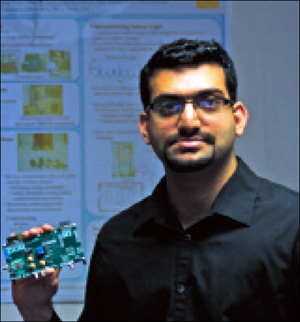The Lewis Ginter Botanical Garden, in Richmond, Va., welcomes visitors who are visually impaired or blind and wish to enjoy the sensory experiences of sound, smell and touch. The garden provides information in Braille, but it’s difficult for individuals who are visually impaired to navigate the landscape and locate the signage while on an auditory tour. For her senior project in biomedical engineering at the Virginia Commonwealth University School of Engineering, Christina Walinski developed an RFID-enabled guide that allows people who are visually impaired to explore the gardens on their own.
The concept is not new. Students at the University of Rochester‘s School of Engineering and Applied Sciences combined RFID readers with CD players to communicate information about tagged items (see Guide for the Visually Impaired). Another RFID guide used passive high-frequency tags (see Swiss Town Rolls Out RFID System for Blind Bus Riders). Both options were cumbersome and challenging for the user.

What is new is the user-friendliness of Walinski’s system. She developed an Android application that runs on a tablet equipped with an ultrahigh-frequency RFID reader.
The tablet reads passive UHF tags within three or four feet and automatically plays the associated audio clips about the flowers. Walinski considered Bluetooth and Wi-Fi for this application, but quickly realized passive UHF technology was the best option because of its ability to read tags within a confined area and communicate the tag data quickly. She scoured the Web for a tablet that could read passive UHF tags from a few feet away and finally found an Android tablet from a Chinese company called Cilico Electronics that has a large UHF antenna, providing several feet of read range.
Walinski worked with garden employees to determine which plants should be tagged and to develop the audio files about each plant. The files also explain how to navigate different pathways within the gardens. A staff member can simply launch the app and give a visitor who is visually impaired a tablet, which fits in a carrying case strapped to the person’s waist.
This summer, Walinski, under the supervision of associate professor Dianne Pawluk, tested the system with six individuals who are visually impaired. The system worked well, but not perfectly. Roughly 15 percent of the time, the tags were not picked up immediately, requiring the visitor to back up so the tags could be read. Still, the feedback was positive. “People were really excited to learn about the plants and flowers,” Walinski says. “And they were pleased to be able to visit the gardens on their own at any time, rather than having to wait for a guided tour.”
Pawluk is currently talking to organizations about commercializing the system.

